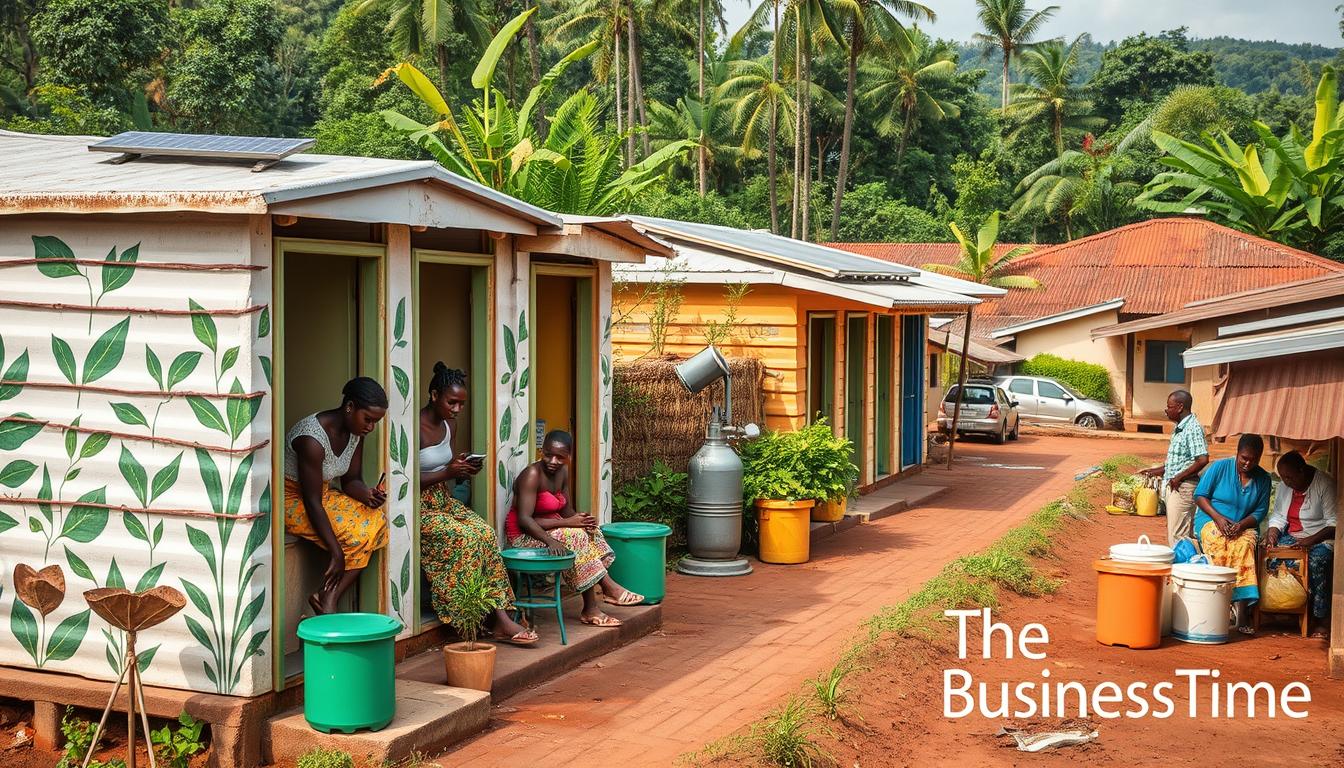We will look closely at how money can help improve health Sanitation and Hygiene Financing Strategy in Uganda. We need to see how every step we take can help make life better for everyone in Uganda.
Did you know less than 20% of Uganda’s rural people have good sanitation? This shows we really need a good sanitation and hygiene plan in Uganda. We must find ways to make public health solutions that work for a long time. Our goal is to start building a strong base for sustainable sanitation in Uganda.
Key Takeaways
- Analyzing the pressing need for improved sanitation and hygiene financing strategy in Uganda.
- Underlining the far-reaching impacts of sustainable sanitation development in Uganda on health and the economy.
- Highlighting strategic investments as keys to unlocking public health solutions.
- Emphasizing the importance of integrating multifaceted approaches to sanitation policy.
- Preparing to delve deeper into the current sanitation landscape and strategic measures to tackle the challenges.
Understanding the Current Sanitation Landscape in Uganda
We’re looking into Uganda’s sanitation problems. We see a big need for better funding for water and sanitation. We want to show you what’s happening in this East African country, especially with clean water access.
Clean water is not available to everyone in Uganda. This is a big problem in rural and poor areas. Even though cities have better sanitation, rural areas are far behind. This affects health and the economy.
- Expansion of existing infrastructure
- Increase in public health awareness campaigns
- Improvements to water quality monitoring systems
We will look at several important factors. A detailed table will show us how access differs, what past efforts have done, and where funding is lacking.
| Indicator | Urban Access (%) | Rural Access (%) | Financing Gap (USD) |
|---|---|---|---|
| Clean Water Availability | 76 | 53 | 150 Million |
| Sanitation Facilities | 79 | 49 | 200 Million |
The table shows big differences in sanitation and water access between cities and rural areas. It also points out the need for more funding to fix these problems.
Fixing Uganda’s sanitation issues needs a team effort. The public and private sectors must work together. We need the right money, policies, and community help to improve sanitation and water access for everyone in Uganda.
Key Factors Influencing Sustainable Sanitation Development in Uganda
We look at three key areas for sustainable sanitation in Uganda. These are infrastructure investment, public health financing, and clean water access. Each one is vital for a strong sanitation system that can face future challenges.
Investment in Sanitation Infrastructure Uganda
Investing in sanitation infrastructure is key for better public health in Uganda. Money for modern sanitation facilities helps lower disease rates. It also boosts local jobs and cuts healthcare costs.
Public Health Financing Uganda
Public health financing is crucial for keeping sanitation efforts going in Uganda. It helps keep the investment in infrastructure and services flowing. This ensures sanitation systems grow with the population’s needs.
Access to Clean Water Uganda
Clean water is essential for good sanitation outcomes. Having safe water sources helps prevent waterborne illnesses. This is a big problem in areas without proper sanitation.
| Aspect | Current State | Future Goals |
|---|---|---|
| Sanitation Infrastructure | Limited access in rural areas | Expand coverage to reach 90% by 2030 |
| Public Health Financing | Reliant on international aid | Increase domestic funding by 50% |
| Clean Water Access | 78% access rate | Achieve universal access by 2030 |
Combining investment in infrastructure, public health financing, and clean water is key. This approach creates a strong system for public health. It improves life quality for everyone in Uganda.
Challenges and Opportunities in Sanitation Financing in Uganda
Financing water and sanitation projects in Uganda is complex. We face many challenges and see new chances for growth. Funding is often short, and sanitation gets less attention, especially in rural areas. But, help from international donors and new ways to fund projects are changing this.
Getting money for rural sanitation is hard due to location and cost. It’s tough to set up big sanitation projects in far-off places. Yet, new tech and funding ideas are making things better.
- Financing Opportunities: New ways like micro-financing and results-based financing are helping. They let local people get involved and benefit from sanitation projects.
- Government and International Aid: The government and international groups are now more involved. This teamwork is key for keeping funding going.
- Community Involvement: When communities help with sanitation, it works better. It makes sure people take care of the projects, which is important for success.
Improving water and sanitation funding in Uganda means fixing financial systems. We need better ways to invest and be open about it. This will help more people get better sanitation services.
Even with big challenges, Uganda’s sanitation financing is getting better. New ideas and teamwork are making a difference. By tackling these issues and using the chances we have, we can make sanitation better. This will help everyone in Uganda stay healthy and happy.
Improved Sanitation and Hygiene Financing Strategy Uganda
We are working hard to create a strong plan for sanitation and hygiene in Uganda. Our goal is to make sure everyone has access to clean water and safe places to go to the bathroom. We want to make sure all parts of Uganda help with this important health issue.
Hygiene Improvement Strategies Uganda
Our main plan is to make Uganda healthier by improving hygiene. We will work with community leaders and run educational programs. We also want to make sure everyone can easily find places to wash their hands.
Sanitation Sector Funding Uganda
We need to find smart ways to pay for these projects. We will ask the government for help and also work with international groups and private companies. They all care about making the world a healthier place.
Rural Sanitation Financing Uganda
Rural areas have special needs. We are making plans that fit their unique situations. We will use money from both local and international sources to help every rural area in Uganda.
We are taking a big step to make Uganda healthier and more sustainable. By working together, we are building a better future for everyone.
Collaborative Approaches to Financing Water and Sanitation Projects in Uganda
Our journey in Uganda focuses on improving life quality. We use teamwork to build water and sanitation projects. This creates a lasting, healthy environment for everyone.
Government Funding for Sanitation in Uganda
Government money is key for water and sanitation projects. A clear policy helps use funds well. This makes sanitation facilities better and more.
Hygiene Programs Funding Uganda
Funding hygiene programs in Uganda is more than just money. It’s about creating programs that meet community needs. Strong funding ensures these programs work well and last long.
Water Sanitation Policy Uganda
The water sanitation policy in Uganda is very important. It guides everyone involved. This policy helps everyone work together to improve water and sanitation.
Here’s a closer look at funding and policies. They work together to make these projects successful:
| Source | Funding Mechanism | Policy Impact |
|---|---|---|
| Government Budgets | Direct Allocations | Foundational Support for Infrastructure |
| Foreign Aid | Grants and Loans | Supplementing National Budgets for Wider Reach |
| Private Sector Investments | Public-Private Partnerships (PPP) | Innovative Solutions and Sustainability |
Working together is more than just sharing money. It’s about having a common goal. As we work together in Uganda’s water and sanitation, we’re building a better future.
Monitoring and Evaluation of Sanitation and Hygiene Investments in Uganda
Monitoring and evaluation are key to the success of health financing in Uganda. They help us see how well sanitation and water projects work. By tracking these efforts, we can tell how they help communities and public health.
In Uganda, it’s important to have clear goals for hygiene projects. This way, we can see if we’re meeting our targets. It also helps make sure money is spent wisely.
We focus a lot on monitoring and evaluation. It helps us learn what works best in Uganda’s sanitation and water projects. Regular checks help us stay on track and make changes when needed.
This way, we make sure money for sanitation and hygiene is used well. It helps everyone in the community.
We strongly support monitoring and evaluation in Uganda’s health financing. These steps are not just rules. They help Uganda’s sanitation grow and improve. We aim to be open and involve the community in these efforts.
FAQ
What is the current state of sanitation in Uganda?
In Uganda, sanitation faces big challenges. There’s not enough clean water and poor sanitation systems. But, people are working hard to fix this. They aim to create better systems and find ways to pay for them.
How critical is investment in sanitation infrastructure for Uganda?
Investing in sanitation is key for Uganda’s health and growth. It stops diseases and makes life better. It also helps the economy by saving money and boosting work.
What are the main hurdles in sanitation financing in Uganda?
Uganda struggles with not enough money for sanitation. It’s hard to get funding and make sure everyone gets help. But, solving these problems is crucial for better sanitation.
How can Uganda improve its sanitation and hygiene financing strategy?
Uganda can do better by using many ways to fund sanitation. It should also focus on rural areas and work with different groups. This multi-faceted approach is important.
Why is collaboration important in financing water and sanitation projects?
Working together is key because it brings different skills and ideas. By teaming up with governments, businesses, and NGOs, projects can be more effective and sustainable.
What role does monitoring and evaluation play in sanitation and hygiene investments?
Monitoring and evaluation are vital. They help see if sanitation efforts are working. This way, we can make smart choices and use resources well.
How can individuals and communities contribute to improved sanitation in Uganda?
People can help by practicing good hygiene and joining local efforts. They should also push for better services and hold leaders accountable. Community support is essential.
What strategies exist for sustainable sanitation development in Uganda?
Uganda uses many strategies for better sanitation. It promotes affordable and green technologies and strengthens laws. It also focuses on changing behaviors and training locals. The goal is to make sanitation last.
Are there any success stories of sanitation improvement in Uganda?
Yes, Uganda has seen success in some areas. Thanks to teamwork between the government, donors, NGOs, and communities, more people have access to sanitation. These successes can inspire others.
What financial mechanisms support sanitation initiatives in Uganda?
Uganda uses many ways to fund sanitation. This includes government money, donor aid, small loans, local groups, and private investment. Each helps in its own way.






I’m not that much of a internet reader to be honest but your blogs really nice, keep it up! I’ll go ahead and bookmark your site to come back down the road. Cheers
You can definitely see your enthusiasm within the work you write. The arena hopes for more passionate writers such as you who are not afraid to say how they believe. All the time go after your heart. “The point of quotations is that one can use another’s words to be insulting.” by Amanda Cross.
Nice blog here! Also your site a lot up very fast! What host are you using? Can I am getting your affiliate hyperlink for your host? I desire my website loaded up as fast as yours lol
Unquestionably believe that that you said. Your favourite reason appeared to be at the internet the easiest factor to remember of. I say to you, I certainly get irked while folks think about issues that they just don’t understand about. You controlled to hit the nail upon the highest as smartly as outlined out the whole thing with no need side-effects , people can take a signal. Will likely be again to get more. Thanks
Youre so cool! I dont suppose Ive learn something like this before. So good to seek out any person with some unique thoughts on this subject. realy thanks for starting this up. this web site is something that is needed on the net, somebody with just a little originality. useful job for bringing something new to the web!
Good ?V I should certainly pronounce, impressed with your site. I had no trouble navigating through all the tabs and related information ended up being truly easy to do to access. I recently found what I hoped for before you know it at all. Reasonably unusual. Is likely to appreciate it for those who add forums or anything, web site theme . a tones way for your client to communicate. Nice task..
I couldn’t resist commenting
Almost all of the things you mention is supprisingly legitimate and it makes me wonder the reason why I had not looked at this with this light before. This article truly did turn the light on for me personally as far as this particular subject matter goes. Nevertheless at this time there is just one factor I am not really too comfy with so whilst I attempt to reconcile that with the core idea of your point, allow me observe what all the rest of your visitors have to point out.Well done.
Hi are using WordPress for your site platform? I’m new to the blog world but I’m trying to get started and set up my own. Do you require any coding knowledge to make your own blog? Any help would be greatly appreciated!
Great post. I am facing a couple of these problems.
A person essentially help to make seriously articles I would state. This is the very first time I frequented your website page and thus far? I surprised with the research you made to make this particular publish extraordinary. Excellent job!
Thanks for this terrific post, I am glad I observed this site on yahoo.
Thank you for every other informative site. Where else may just I am getting that type of information written in such a perfect approach? I have a venture that I am simply now running on, and I’ve been on the glance out for such info.
My partner and I stumbled over here from a different page and thought I might as well check things out. I like what I see so now i am following you. Look forward to looking over your web page repeatedly.
Hello! Someone in my Myspace group shared this site with us so I came to look it over. I’m definitely loving the information. I’m book-marking and will be tweeting this to my followers! Fantastic blog and terrific design and style.
There’s noticeably a bundle to know about this. I assume you made sure good points in options also.
Thank you, I have recently been searching for information approximately this topic for a while and yours is the greatest I’ve found out till now. But, what in regards to the bottom line? Are you positive about the source?
Simply wanna input on few general things, The website pattern is perfect, the written content is really good : D.